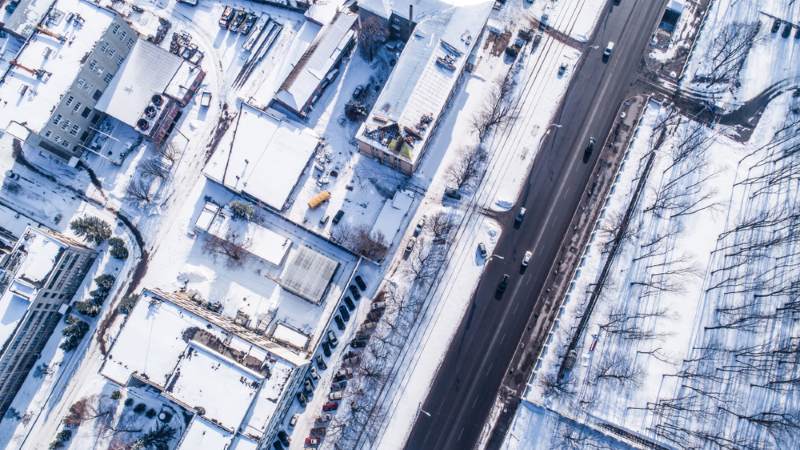When snow begins to fall, most people think about traffic delays, icy sidewalks, or whether it’s time to dig out the snowblower. But if you’re a property owner or facilities manager, there’s something much more serious to worry about—your roof.
Heavy snow accumulation can place enormous strain on building structures, leading to sagging, cracking, and in some cases, total roof collapse. Each year, winter storms cause millions of dollars in damage to commercial and industrial buildings across the country. Yet most of these incidents are entirely preventable with a professional snow-load analysis conducted before the season begins.
What Is a Snow-Load Analysis?
A snow-load analysis is a professional evaluation of how much weight your roof system can safely support. It accounts for numerous variables, including the type of roof, its slope, materials used, drainage systems, insulation, snow drift potential, and regional climate data. This is not a one-size-fits-all formula—calculating safe limits requires a site-specific approach backed by engineering data.
The density of snow is often underestimated. One foot of fresh, powdery snow may weigh as little as 5 pounds per square foot (psf), while a foot of wet, compacted snow can exceed 20 psf. Add ice accumulation or uneven snow distribution due to drifting, and stress on the roof increases exponentially. Without proactive assessment, building owners are gambling every winter storm season.
Which Buildings Are Most at Risk?
Not every property needs a snow-load analysis every year—but many do. You’re at higher risk if:
- Your building has a flat or low-slope roof that allows snow to accumulate.
- You’ve installed new HVAC units, solar panels, or rooftop equipment that adds weight or causes drifts.
- Your building is more than 20 years old and may not meet current snow-load codes.
- You’ve experienced past issues with roof leaks, ice dams, or ceiling stress.
- You’ve made structural changes or renovations that altered roof performance.
Even newer buildings can be vulnerable if built to outdated regional data, or if they've been exposed to extreme snow or wind events. Snow accumulation patterns can change dramatically with local topography, nearby structures, and prevailing wind direction.
Why Timing Matters: Schedule Before the Storms
Scheduling a snow-load evaluation before winter is not just convenient—it’s essential. Waiting until snow starts to fall can leave you scrambling for emergency solutions with limited time and options. Once the first heavy snow hits, it becomes more difficult—and risky—to inspect or access your roof safely.
By conducting the evaluation ahead of the season, you’ll receive tailored recommendations that help you prepare. These may include maximum snow-depth limits for removal, identifying vulnerable areas, improving drainage, or reinforcing load-bearing structures.
What to Expect from a Snow-Load Analysis
When you hire our team at Allin Rose, we don’t just take a quick look at your roof; we perform a full assessment using professional-grade tools and proven methodology. Our snow and ice consulting services typically include:
- Structural load calculations based on local snow-load codes
- Detailed inspection of roof framing, support beams, and insulation
- Identification of snowdrift zones and weak points
- Recommendations for safe snow-removal thresholds
- Emergency load reduction protocols if snowfall exceeds safe levels
This proactive information empowers you to prevent damage, reduce liability, and comply with applicable building and safety codes.
Warning Signs You Shouldn't Ignore
If you’re already noticing signs of stress on your building, schedule an inspection immediately. Common red flags include:
- Cracking sounds or visual sagging in ceilings or walls
- Leaking after snowmelt, especially near roof edges or skylights
- Ceiling tiles shifting or becoming discolored
- Sudden difficulty opening doors or windows, indicating structural shift
- Persistent or worsening ice dam formation
These symptoms suggest your roof is already struggling under existing snow loads and may not survive additional accumulation. Don’t wait until a minor issue becomes catastrophic.
Why It’s Worth the Investment
A snow-load analysis is a modest investment compared to the cost of repairs or litigation. Insurance companies may deny claims if they believe you failed to maintain your property or ignored known risks. Worse, injuries to employees or visitors caused by a roof collapse can lead to severe legal consequences.
In contrast, a documented, professional analysis shows you took appropriate steps to assess risk and plan ahead. It’s a tool not just for safety but also for liability protection and operational continuity.
Be Proactive This Winter and Don’t Get Caught Off Guard
Each year, we see clients caught off guard by unexpected weather events. With climate patterns shifting and extreme snow events becoming more common in areas that didn’t previously experience them, the need for a snow-load analysis is more urgent than ever.
Whether you manage one commercial property or an entire portfolio, understanding your buildings’ snow-load capacity is essential for safe winter operations. We offer fast, reliable consultations and provide actionable recommendations tailored to your unique property and risk profile.
Contact Allin Rose today to schedule your expert snow-load analysis. Winter doesn’t wait—and neither should you.













